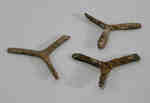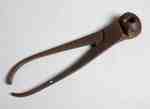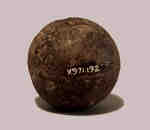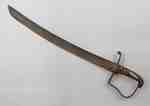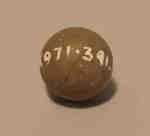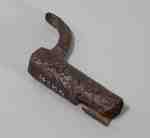1812 History

The 1812 History Project is an effort to make records and artefacts from the War of 1812 era accessible. The history of the War of 1812 is far reaching. There is much to learn and share.
Records
Results
- These prickers, dated 1812, were used as a screwdriver for a musket. It is “Y” shaped, with the top “V” forming the handle and the bottom arm narrowing to fit into the screw. The musket tool was usedThese prickers, dated 1812, were used as a screwdriver for a musket. …
- The sword, which is made of brass and steel, has a lion's head pommel and a curved blade. Along with its scabbard, it is believed to have belonged to the Musician in Captain Raunchey's Volunteers (CoThe sword, which is made of brass and steel, has a lion's …
- This is a wooden ramrod, circa 1812-1814, that was used by the artillery to wedge the ball into the breech of the cannon. 196 cm long and painted black.This is a wooden ramrod, circa 1812-1814, that was used by the …
- This triangular bladed bayonet was designed to fit on the muzzle of a rifle or musket barrel, making it into a close range weapon. This would have been on arguably every soldier’s firearm during theThis triangular bladed bayonet was designed to fit on the muzzle of …
- This sword belonged to Capt. James Muirhead during the War of 1812-1814. The hilt of the sword is made of brass with a sharkskin grip and a lion’s head pommel. The guard of the hilt is also made up oThis sword belonged to Capt. James Muirhead during the War of 1812-1814. …
- This musket, circa 1812, is a 3rd Model “Brown Bess” 1790 with an “India Pattern” design. It was a British regulation issue flintlock musket. There are various engravings on the musket that include:This musket, circa 1812, is a 3rd Model “Brown Bess” 1790 with …
- This is an American metal musket ball mold of a plier design, dated 1812-1814. It was used to press a musket ball to the size of a bore or rifle, approximately .69 calibre musket balls. The press endThis is an American metal musket ball mold of a plier design, …
- This bayonet is of an officer’s fusil musket design. It has a triangular blade and is date circa 1812. A bayonet is a steel blade that is designed to fit on the muzzle of a rifle or musket barrel, maThis bayonet is of an officer’s fusil musket design. It has a …
- This officer's flintlock pistol features a brass butt plate, a trigger guard and a ramrod holder. The pistol is made of walnut with a steel barrel. This pistol dates from 1800-1830 and would likely bThis officer's flintlock pistol features a brass butt plate, a trigger guard …
- This iron fashioned ammunition was created during the War of 1812 period. It gives an insight into the appearance of military munitions during the 1812 time. Diameter: 3.2 cmThis iron fashioned ammunition was created during the War of 1812 period. …
- This iron fashioned ammunition was likely created during the War of 1812 period. It gives an insight into the appearance of military munitions during the 1812 time. Diameter: 5 cmThis iron fashioned ammunition was likely created during the War of 1812 …
- This cotton flag features a colonial Union Jack design and a stamp that reads "War of 1812". Although the flag is hand-stitched, it is not clear whether the flag was used during the War of 1812 or noThis cotton flag features a colonial Union Jack design and a stamp …
- This musket, circa1812, with its ramrod attached, is a flintlock converted to a percussion steel firing mechanism. The barrel is steel and the stock is made of walnut. The marks include: the HanoveriThis musket, circa1812, with its ramrod attached, is a flintlock converted to …
- A steel sabre, with a wooden grip, that is cavalry issue dated during the War of 1812. It was found on the banks of the Niagara river.A steel sabre, with a wooden grip, that is cavalry issue dated …
- Original donated and identified as a clay musket ball with a circumference of 5cm. It is highly doubtful that such an item would ever be used effectively as a musket ball and is more likely a marbleOriginal donated and identified as a clay musket ball with a circumference …
- This is an officer’s sword that has the inscription “Capt’n Daniel Servos, Butler’s Rangers 1778” on its scabbard. The hilt is silver and green with an eagle on the pommel. The sword was donated to tThis is an officer’s sword that has the inscription “Capt’n Daniel Servos, …
- This bar shot was found at the mouth of the Niagara River and is believed to be British. It is two solid cast iron balls connected by a bar to form a shape of a “dumbbell”. Bar shots were cannon weapThis bar shot was found at the mouth of the Niagara River …
- This is a fragment from one of the original Blockhouses located at Fort George. The date associated with this fragment is 1792. However, Fort George was originally completed in 1802. Therefore, it caThis is a fragment from one of the original Blockhouses located at …
- This is a bayonet socket with a small portion of the blade attached that was discovered in the Niagara River. A bayonet is a steel blade that is designed to fit on the muzzle of a rifle or musket barThis is a bayonet socket with a small portion of the blade …
- This is an ammunition chest made of wood, canvas and iron, and measures 272.5 x 56.3 x 52.5 CM. It has a curved lid covered with canvas with iron strapping, and angled iron on the four corners with iThis is an ammunition chest made of wood, canvas and iron, and …





